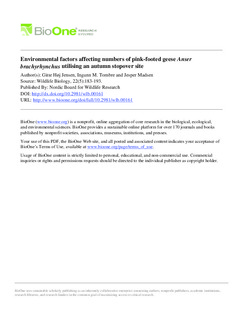Environmental factors affecting numbers of pink-footed geese Anser brachyrhynchus utilising an autumn stopover site
Journal article, Peer reviewed
Permanent lenke
http://hdl.handle.net/11250/2405453Utgivelsesdato
2016Metadata
Vis full innførselSamlinger
- Publikasjoner fra CRIStin - NINA [2364]
- Scientific publications [1392]
Sammendrag
NorwayFor
huntable waterbird species, the autumn migration strategy may be important for their fitness, as their behaviour and
environmental factors may influence their exposure to hunting mortality. Hunting activity may also reduce the access to
food resources which may be limited in the wintering areas, thereby affecting winter survival. In this study we assessed the
possible influence of food resources, weather conditions, inter-specific competition and hunting intensity (as a measure
of possible disturbance) on abundance and distribution of pink-footed geese Anser brachyrhynchus at their main autumn
stopover site in Norway. The results show that food resources in term of spilt cereal grain were abundant, even by the time
the geese had moved on. Snow cover did not limit the food availability during the main migratory period. Inter-specific
competition with greylag geese Anser anser reduced food supplies locally and appeared to be increasing. Goose hunting
intensity varied among sites and our data indicate a negative relationship between hunting intensity and the rate at which
geese consumed the food resources. Collectively, our results suggest that the majority of pink-footed geese leave the stopover
area earlier than they would otherwise, when hunting intensities are high. In the case of pink-footed geese, population
consequences of disturbance is not a concern at present; however, an international species management plan calls for 1)
keeping disturbance low in areas where geese do not cause conflicts with agriculture to prevent them being pushed to areas
with problems, and 2) increased harvest to reduce and stabilise the population size. Both objectives can be met by reducing
hunting disturbance in mid-Norway and it is recommended that a better local organisation of hunting is implemented.

